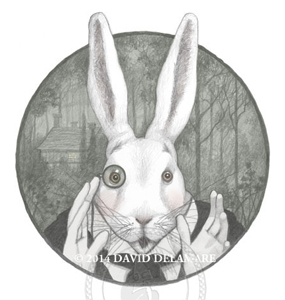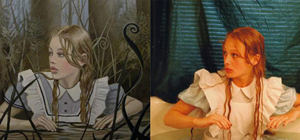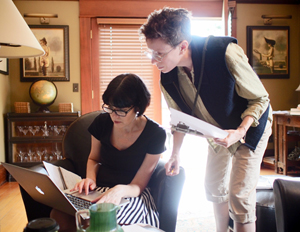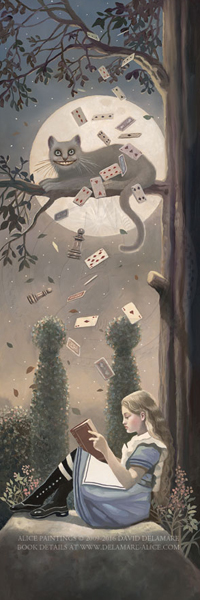BOOK FAQs
Please click on the links below to view answers.
Almost eight years. Our journey began in 2009 when David was working on a painting entitled "Beware the Jabberwock." It was then that he first imagined all the Wonderland characters (other than Alice) as animals. Fortunately, we happened to document the evolution of that painting. You can witness the moment of inspiration in this slideshow. For best view on a phone, rotate your device horizontally.
We launched our Kickstarter campaign in December 2013 and the books finished shipping to backers in early 2017. David died suddenly in September 2016 on the very morning that the book began binding.
We launched our Kickstarter campaign in December 2013 and the books finished shipping to backers in early 2017. David died suddenly in September 2016 on the very morning that the book began binding.
Why did you crowdfund this book?
We launched a Kickstarter campaign because we wanted to include deluxe features that most publishers can't or won’t fund. What we didn't expect was how working for backers would inspire us to raise our standards even higher. Backer involvement and encouragement led to the following features:
The Alice book involved far more work than we initially imagined and took us deep into debt. But we felt very fortunate to have worked on such a meaningful project with a community of individuals who shared our passion for quality and legacy.
- More illustrations: 32 oil paintings and 62 drawings.
- A new historically authentic text.
- Textually relevant color images on every page spread.
- Carefully selected page endings (for ease of reading aloud).
- Deluxe foil-stamped slipcase and sewn-in ribbon bookmark.
The Alice book involved far more work than we initially imagined and took us deep into debt. But we felt very fortunate to have worked on such a meaningful project with a community of individuals who shared our passion for quality and legacy.
What media were used to create the artwork?
The rectangular images in the book (and on this website) were traditional oil paintings on canvas. The free-standing images were traditional pencil drawings. Early on, we decided that we wanted the book to be full-color, so we explored various ways to subtly tint the pencil drawings. Eventually, we decided that coloring them digitally best preserved details.


Who modeled for Alice and how old was she?
Cameron Moore, our Alice model and muse, was nineteen when she began working with us. We considered models from a wide age range, because we were primarily interested in Alice's imagined internal world, rather than a literal interpretation of the text.
We chose to work with Cameron partly because of her fairytale appearance but, also, because she felt like Alice to us. She was bright, independent, literate, imaginative, and possessed an ineffable magical quality.
Cameron was also a great sport. For the "house" scene, she scrunched herself into a small cardboard box. For the "pool of tears" scene, she immersed herself, fully costumed, into our clawfoot tub.

We chose to work with Cameron partly because of her fairytale appearance but, also, because she felt like Alice to us. She was bright, independent, literate, imaginative, and possessed an ineffable magical quality.
Cameron was also a great sport. For the "house" scene, she scrunched herself into a small cardboard box. For the "pool of tears" scene, she immersed herself, fully costumed, into our clawfoot tub.

Why are the colors in the book so subtle?
The story takes place underground, so David imagined the light would be subdued. But, also, he felt that the tone of the original text was more reflective than active. Finally, the focus of David's work was on Alice's internal experience, which was generally contemplative.
What's all the fuss about the text? Isn't it standardized?
Not at all. Lewis Carroll tinkered with the text for many years and different versions varied in punctuation and wording. Our goal was to create an edition that would best resemble what Carroll would have chosen at the time of his death.
Our version is very close to his final (Macmillan, 1897) edition. Minor corrections were made based upon exhaustive research by Selwyn H. Goodacre and extensive discussion with experts and a team of volunteers. The decisions weren't all easy and some were a bit subjective. (We will eventually launch a website that will describe all this in depth.) Photo, taken by Katie Van Heest, is of publisher Wendy Ice (left) and volunteer/backer Jan Groh (right) making last minute corrections to the text.

Our version is very close to his final (Macmillan, 1897) edition. Minor corrections were made based upon exhaustive research by Selwyn H. Goodacre and extensive discussion with experts and a team of volunteers. The decisions weren't all easy and some were a bit subjective. (We will eventually launch a website that will describe all this in depth.) Photo, taken by Katie Van Heest, is of publisher Wendy Ice (left) and volunteer/backer Jan Groh (right) making last minute corrections to the text.

How were volunteers involved with the book?
We worked with many volunteers from multiple countries. It's staggering to consider how much assistance we had. This book was built by a community. Volunteers helped with:
If we could have afforded it, we might have hired assistance, but this wouldn't have had such impressive results. Instead of one proofreader, for instance, we had an entire international team that included a number of highly qualified professionals. Each team member discovered different issues and made a unique contribution. Perhaps more importantly, each was involved out of real passion and joy. Working together was great fun.
- Printing and color management advice.
- Crowdfunding advice.
- Business and Legal advice.
- Proofreading and editing.
- Layout review.
- Typesetting.
If we could have afforded it, we might have hired assistance, but this wouldn't have had such impressive results. Instead of one proofreader, for instance, we had an entire international team that included a number of highly qualified professionals. Each team member discovered different issues and made a unique contribution. Perhaps more importantly, each was involved out of real passion and joy. Working together was great fun.
What's next?
Currently, David’s widow Wendy Ice is sharing the David Delamare Archive Project on Facebook. Every day, she shows a different image from the archives. (There are so many images that the project will last several years.)
She is also building a new print-on-demand website that will allow collectors to purchase almost any Delamare image in a wide range of custom sizes.
Very soon, she will launch a Patreon campaign to begin work on a book about the power of patronage. (Eventually that book will either be picked up by a publisher or launched on Kickstarter.) Patreon patrons will be given an intimate tour through David’s creative life and will see his private sketch books. They will also be encouraged to tell stories and engage in discussion about creativity, inspiration, and patronage.
Other future projects include coffee table art books (including a fairy book, a mermaid book, a book of nudes, and a full retrospective). To be informed about these projects, please follow the David Delamare Art page on Facebook.
She is also building a new print-on-demand website that will allow collectors to purchase almost any Delamare image in a wide range of custom sizes.
Very soon, she will launch a Patreon campaign to begin work on a book about the power of patronage. (Eventually that book will either be picked up by a publisher or launched on Kickstarter.) Patreon patrons will be given an intimate tour through David’s creative life and will see his private sketch books. They will also be encouraged to tell stories and engage in discussion about creativity, inspiration, and patronage.
Other future projects include coffee table art books (including a fairy book, a mermaid book, a book of nudes, and a full retrospective). To be informed about these projects, please follow the David Delamare Art page on Facebook.
I like what you're doing. How can I help?
We need your help. Our tiny studio can't accomplish this sort of ambitious work alone. Here are a few ways to get involved:
- Use social media to tell others about our projects.
- Volunteer your skills to help with the next project.
- Purchase books or artwork for yourself or as gifts.
- Leave positive book reviews wherever you can.
- Donate to our studio. (We can't afford to say no.)
- Most importantly: enjoy the art and keep sending encouragement!
Where may I learn more about Lewis Carroll?
Begin by joining a Lewis Carroll society near you (see our Alice links page) and, if you don't have one, find a copy of the newly revised Annotated Alice by Martin Gardner. It offers a cornucopia of fascinating facts about Lewis Carroll, Alice Liddell (the girl who inspired the tale) and the book.
